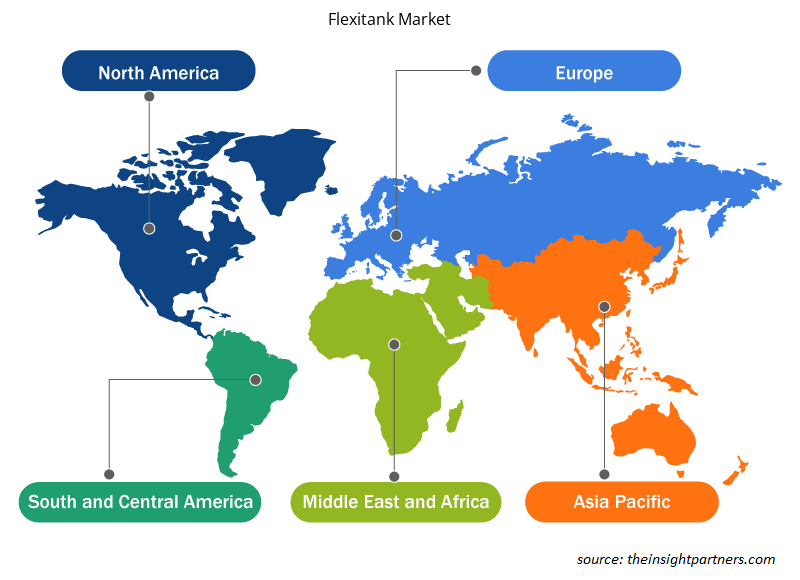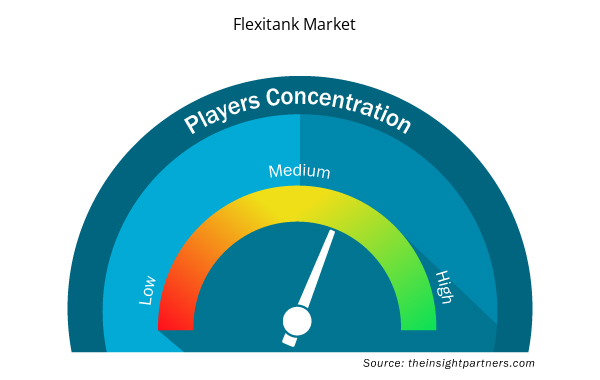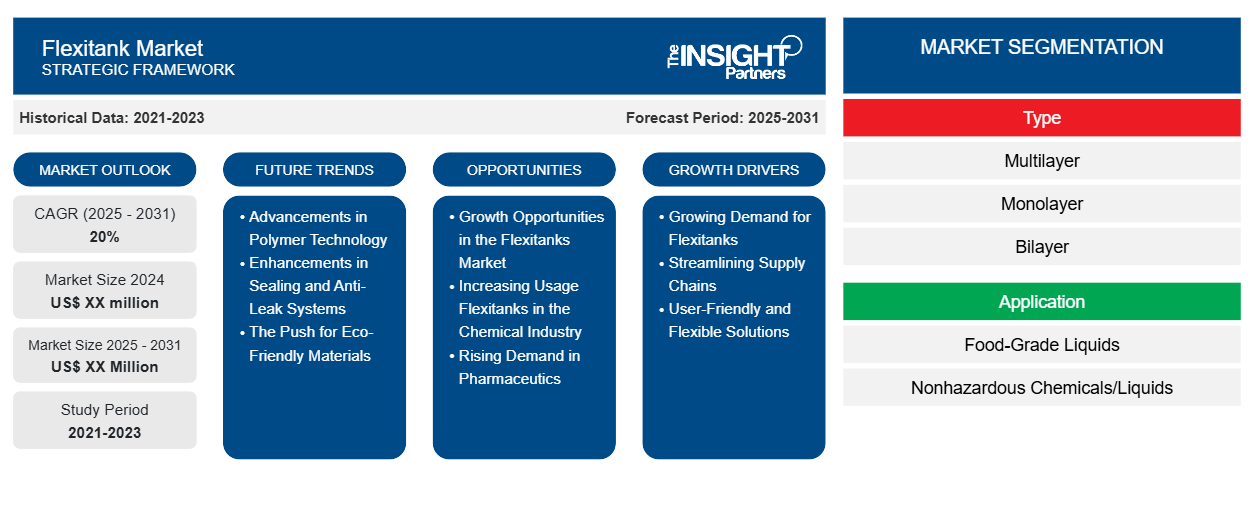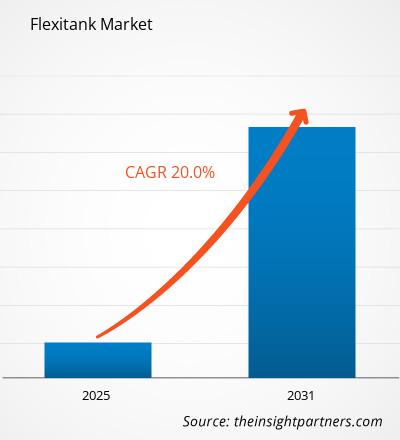Se espera que el mercado de flexitanques registre una CAGR del 20 % entre 2024 y 2031, con un tamaño de mercado que se expandirá de US$ XX millones en 2024 a US$ XX millones en 2031.
El informe presenta un análisis basado en el tipo (multicapa, monocapa y bicapa). El informe está segmentado por aplicación (líquidos de grado alimenticio, productos químicos/líquidos no peligrosos y otros). El análisis global se desglosa aún más a nivel regional y por países principales. El tamaño del mercado y el pronóstico a nivel global, regional y de país para todos los segmentos clave del mercado están cubiertos bajo el alcance. El informe ofrece el valor en USD para el análisis y los segmentos anteriores. El informe proporciona estadísticas clave sobre el estado del mercado de los actores clave del mercado y ofrece tendencias y oportunidades del mercado.
Propósito del Informe
El informe Flexitank Market de The Insight Partners tiene como objetivo describir el panorama actual y el crecimiento futuro, los principales factores impulsores, los desafíos y las oportunidades. Esto proporcionará información a diversas partes interesadas del negocio, como:
- Proveedores/fabricantes de tecnología: Para comprender la dinámica cambiante del mercado y conocer las oportunidades potenciales de crecimiento, lo que les permitirá tomar decisiones estratégicas informadas.
- Inversionistas: Realizar un análisis exhaustivo de tendencias sobre la tasa de crecimiento del mercado, las proyecciones financieras del mercado y las oportunidades que existen en toda la cadena de valor.
- Órganos reguladores: Regular las políticas y vigilar las actividades del mercado con el objetivo de minimizar los abusos, preservar la confianza de los inversores y defender la integridad y la estabilidad del mercado.
Segmentación del mercado de flexitanques
Tipo
- Multicapa
- Monocapa
- Bicapa
Solicitud
- Líquidos de calidad alimentaria
- Productos químicos y líquidos no peligrosos
Personalice este informe según sus necesidades
Obtendrá personalización en cualquier informe, sin cargo, incluidas partes de este informe o análisis a nivel de país, paquete de datos de Excel, así como también grandes ofertas y descuentos para empresas emergentes y universidades.
- Obtenga las principales tendencias clave del mercado de este informe.Esta muestra GRATUITA incluirá análisis de datos, desde tendencias del mercado hasta estimaciones y pronósticos.
Factores impulsores del crecimiento del mercado de flexitanques
- Demanda creciente de flexitanques: los flexitanques tienen una gran demanda como un medio rentable para transportar líquidos a granel de una manera económicamente eficaz. La creciente necesidad de un transporte eficiente de cargas de líquidos está impulsando la demanda en el mercado. Las industrias de alimentos y bebidas, productos químicos y farmacéuticas están utilizando flexitanques porque optimizan el espacio dentro de los contenedores.
- Optimización de las cadenas de suministro: a medida que se expande el comercio internacional, las empresas necesitarán soluciones imaginativas que ayuden a optimizar los procesos de sus cadenas de suministro. Los flexitanks permiten transportar mayores volúmenes de líquidos en contenedores de transporte regulares. Esta eficiencia permite ahorrar costos de envío y contribuye a reducir la degradación ambiental, factores que podrían formar parte de los objetivos de sostenibilidad que la mayoría de las organizaciones están tratando de alcanzar.
- Soluciones flexibles y fáciles de usar: Además, han surgido los flexitanques, que son fáciles de usar y flexibles. Son más rápidos de montar y requieren menos limpieza en comparación con los cisternas tradicionales. La flexibilidad en este mercado de rápido crecimiento es crucial en términos de tiempo y recursos. Las empresas buscan la eficiencia en las operaciones y, por lo tanto, continúan solicitando estas soluciones.
Tendencias futuras del mercado de flexitanques
- Avances en la tecnología de polímeros: Las innovaciones en la tecnología de polímeros, junto con nuevos avances en la ciencia de los materiales que podrían conducir a una nueva era de materiales más robustos, livianos pero más confiables y duraderos, han llevado a los consumidores a disfrutar de una mayor seguridad y confiabilidad asociadas con los flexitanques.
- Mejoras en los sistemas de sellado y antifugas: Los nuevos diseños, que incluyen mejores sistemas de sellado y antifugas, también contribuyen al crecimiento del mercado. Estas características evitan la contaminación y las fugas, que han sido la mayor fuente de preocupación para muchos fabricantes y proveedores de logística. Las empresas ahora están optando por métodos de transporte seguros y protegidos, y las actualizaciones tecnológicas en dichos parámetros se están volviendo cada vez más esenciales para cumplir con los estándares industriales.
- La demanda de materiales ecológicos: Además, los materiales ecológicos constituyen un área de investigación en rápido crecimiento. Con el objetivo de ser ecológicos, los fabricantes de flexitanques exploran materiales biodegradables o reciclables, ya que pueden reducir la exposición a daños ambientales y atraer a empresas con mentalidad ecológica para mantener una base de clientes ecológica.
Oportunidades de mercado de flexitanques
- Oportunidades de crecimiento en el mercado de flexitanques: La expansión en otras industrias como la química, farmacéutica y cosmética presenta grandes vías de crecimiento para el mercado de flexitanques, que ya no se limita al sector de alimentos y bebidas, donde la mayor parte de su uso inicial era en el transporte de líquidos.
- Uso cada vez más frecuente de flexitanques en la industria química: En la industria química, recientemente se ha convertido en una práctica común el transporte de líquidos no peligrosos en flexitanques, lo que ofrece una alternativa económica a las opciones tradicionales de cisternas. Los flexitanques son tubos grandes prefabricados, hechos de material plástico/PVC flexible. Permiten el envío a granel manteniendo la integridad del producto. Los fabricantes que necesitan una solución logística muy eficiente lo encuentran atractivo. Esta sería una tendencia saludable para aplicaciones que abarquen una gama mucho más amplia de carga líquida.
- Demanda creciente en productos farmacéuticos: el uso de flexitanques para transportar grandes volúmenes de líquidos, como vacunas y otros suministros médicos, también resulta ventajoso para la industria farmacéutica. Junto con los beneficios del uso de flexitanques, como la limitación de los riesgos de contaminación y la garantía de la calidad del producto, surge la necesidad de métodos de transporte seguros y fiables. La aceptación de los productos farmacéuticos está creciendo con estos avances actuales, lo que favorece la demanda en el futuro.
Perspectivas regionales del mercado de flexitanques
Los analistas de Insight Partners explicaron en detalle las tendencias y los factores regionales que influyen en el mercado de flexitanques durante el período de pronóstico. Esta sección también analiza los segmentos y la geografía del mercado de flexitanques en América del Norte, Europa, Asia Pacífico, Oriente Medio y África, y América del Sur y Central.

- Obtenga los datos regionales específicos para el mercado de flexitanques
Alcance del informe sobre el mercado de flexitanques
| Atributo del informe | Detalles |
|---|---|
| Tamaño del mercado en 2024 | XX millones de dólares estadounidenses |
| Tamaño del mercado en 2031 | US$ XX millones |
| Tasa de crecimiento anual compuesta (CAGR) global (2025-2031) | 20% |
| Datos históricos | 2021-2023 |
| Período de pronóstico | 2025-2031 |
| Segmentos cubiertos | Por tipo
|
| Regiones y países cubiertos | América del norte
|
| Líderes del mercado y perfiles de empresas clave |
|
Densidad de actores del mercado de flexitanques: comprensión de su impacto en la dinámica empresarial
El mercado de flexitanques está creciendo rápidamente, impulsado por la creciente demanda de los usuarios finales debido a factores como la evolución de las preferencias de los consumidores, los avances tecnológicos y una mayor conciencia de los beneficios del producto. A medida que aumenta la demanda, las empresas amplían sus ofertas, innovan para satisfacer las necesidades de los consumidores y aprovechan las tendencias emergentes, lo que impulsa aún más el crecimiento del mercado.
La densidad de actores del mercado se refiere a la distribución de las empresas o firmas que operan dentro de un mercado o industria en particular. Indica cuántos competidores (actores del mercado) están presentes en un espacio de mercado determinado en relación con su tamaño o valor total de mercado.
Las principales empresas que operan en el mercado de Flexitanks son:
- Nacido
- Transporte de líquidos a granel
- Büscherhoff Soluciones de embalaje GmbH
- Flexitanques TRUST
- Hillebrand
Descargo de responsabilidad : Las empresas enumeradas anteriormente no están clasificadas en ningún orden particular.

- Obtenga una descripción general de los principales actores clave del mercado Flexitank
Puntos de venta clave
- Cobertura integral: el informe cubre de manera integral el análisis de productos, servicios, tipos y usuarios finales del mercado Flexitank, proporcionando un panorama holístico.
- Análisis de expertos: el informe se compila sobre la base de un profundo conocimiento de expertos y analistas de la industria.
- Información actualizada: El informe asegura relevancia comercial debido a su cobertura de información reciente y tendencias de datos.
- Opciones de personalización: este informe se puede personalizar para satisfacer los requisitos específicos del cliente y adaptarse adecuadamente a las estrategias comerciales.
Por lo tanto, el informe de investigación sobre el mercado de flexitanques puede ayudar a abrir camino para descifrar y comprender el escenario de la industria y las perspectivas de crecimiento. Si bien puede haber algunas preocupaciones válidas, los beneficios generales de este informe tienden a superar las desventajas.
- Análisis histórico (2 años), año base, pronóstico (7 años) con CAGR
- Análisis PEST y FODA
- Tamaño del mercado Valor/volumen: global, regional, nacional
- Industria y panorama competitivo
- Conjunto de datos de Excel


- Military Rubber Tracks Market
- Artwork Management Software Market
- Molecular Diagnostics Market
- Asset Integrity Management Market
- High Speed Cable Market
- Dry Eye Products Market
- Vision Guided Robotics Software Market
- Medical Enzyme Technology Market
- Oxy-fuel Combustion Technology Market
- Latent TB Detection Market

Report Coverage
Revenue forecast, Company Analysis, Industry landscape, Growth factors, and Trends

Segment Covered
This text is related
to segments covered.

Regional Scope
North America, Europe, Asia Pacific, Middle East & Africa, South & Central America

Country Scope
This text is related
to country scope.
Preguntas frecuentes
Technological advancements in flexitank materials and design is expected to be the key market trends.
Based on type, the multilayer segment is expected to witness the fastest growth during the forecast period
Based on geography, Asia Pacific held the largest share of the flexitank market as governments of various countries in Asia Pacific are concentrating on expanding exports, which is expected to provide lucrative opportunities to the market.
The growing demand for efficient liquid cargo transportation is driving the market growth.
Bornit; Bulk Liquid Transport; Büscherhoff Packaging Solutions GmbH; TRUST Flexitanks; Hillebrand; MY FlexiTank (MYF); Kricon Group; Qingdao LAF Packaging Co., Ltd.; Bulk Liquid Solutions; and Abrao Group are some of the key players operating in the flexitank market
The Flexitank Market is estimated to witness a CAGR of 20% from 2023 to 2031
The List of Companies
- Bornit
- Bulk Liquid Transport
- Büscherhoff Packaging Solutions GmbH
- TRUST Flexitanks
- Hillebrand
- MY FlexiTank (MYF)
- Kricon Group
- Qingdao LAF Packaging Co., Ltd.
- Bulk Liquid Solutions
- Abrao Group
The Insight Partners performs research in 4 major stages: Data Collection & Secondary Research, Primary Research, Data Analysis and Data Triangulation & Final Review.
- Data Collection and Secondary Research:
As a market research and consulting firm operating from a decade, we have published and advised several client across the globe. First step for any study will start with an assessment of currently available data and insights from existing reports. Further, historical and current market information is collected from Investor Presentations, Annual Reports, SEC Filings, etc., and other information related to company’s performance and market positioning are gathered from Paid Databases (Factiva, Hoovers, and Reuters) and various other publications available in public domain.
Several associations trade associates, technical forums, institutes, societies and organization are accessed to gain technical as well as market related insights through their publications such as research papers, blogs and press releases related to the studies are referred to get cues about the market. Further, white papers, journals, magazines, and other news articles published in last 3 years are scrutinized and analyzed to understand the current market trends.
- Primary Research:
The primarily interview analysis comprise of data obtained from industry participants interview and answers to survey questions gathered by in-house primary team.
For primary research, interviews are conducted with industry experts/CEOs/Marketing Managers/VPs/Subject Matter Experts from both demand and supply side to get a 360-degree view of the market. The primary team conducts several interviews based on the complexity of the markets to understand the various market trends and dynamics which makes research more credible and precise.
A typical research interview fulfils the following functions:
- Provides first-hand information on the market size, market trends, growth trends, competitive landscape, and outlook
- Validates and strengthens in-house secondary research findings
- Develops the analysis team’s expertise and market understanding
Primary research involves email interactions and telephone interviews for each market, category, segment, and sub-segment across geographies. The participants who typically take part in such a process include, but are not limited to:
- Industry participants: VPs, business development managers, market intelligence managers and national sales managers
- Outside experts: Valuation experts, research analysts and key opinion leaders specializing in the electronics and semiconductor industry.
Below is the breakup of our primary respondents by company, designation, and region:

Once we receive the confirmation from primary research sources or primary respondents, we finalize the base year market estimation and forecast the data as per the macroeconomic and microeconomic factors assessed during data collection.
- Data Analysis:
Once data is validated through both secondary as well as primary respondents, we finalize the market estimations by hypothesis formulation and factor analysis at regional and country level.
- Macro-Economic Factor Analysis:
We analyse macroeconomic indicators such the gross domestic product (GDP), increase in the demand for goods and services across industries, technological advancement, regional economic growth, governmental policies, the influence of COVID-19, PEST analysis, and other aspects. This analysis aids in setting benchmarks for various nations/regions and approximating market splits. Additionally, the general trend of the aforementioned components aid in determining the market's development possibilities.
- Country Level Data:
Various factors that are especially aligned to the country are taken into account to determine the market size for a certain area and country, including the presence of vendors, such as headquarters and offices, the country's GDP, demand patterns, and industry growth. To comprehend the market dynamics for the nation, a number of growth variables, inhibitors, application areas, and current market trends are researched. The aforementioned elements aid in determining the country's overall market's growth potential.
- Company Profile:
The “Table of Contents” is formulated by listing and analyzing more than 25 - 30 companies operating in the market ecosystem across geographies. However, we profile only 10 companies as a standard practice in our syndicate reports. These 10 companies comprise leading, emerging, and regional players. Nonetheless, our analysis is not restricted to the 10 listed companies, we also analyze other companies present in the market to develop a holistic view and understand the prevailing trends. The “Company Profiles” section in the report covers key facts, business description, products & services, financial information, SWOT analysis, and key developments. The financial information presented is extracted from the annual reports and official documents of the publicly listed companies. Upon collecting the information for the sections of respective companies, we verify them via various primary sources and then compile the data in respective company profiles. The company level information helps us in deriving the base number as well as in forecasting the market size.
- Developing Base Number:
Aggregation of sales statistics (2020-2022) and macro-economic factor, and other secondary and primary research insights are utilized to arrive at base number and related market shares for 2022. The data gaps are identified in this step and relevant market data is analyzed, collected from paid primary interviews or databases. On finalizing the base year market size, forecasts are developed on the basis of macro-economic, industry and market growth factors and company level analysis.
- Data Triangulation and Final Review:
The market findings and base year market size calculations are validated from supply as well as demand side. Demand side validations are based on macro-economic factor analysis and benchmarks for respective regions and countries. In case of supply side validations, revenues of major companies are estimated (in case not available) based on industry benchmark, approximate number of employees, product portfolio, and primary interviews revenues are gathered. Further revenue from target product/service segment is assessed to avoid overshooting of market statistics. In case of heavy deviations between supply and demand side values, all thes steps are repeated to achieve synchronization.
We follow an iterative model, wherein we share our research findings with Subject Matter Experts (SME’s) and Key Opinion Leaders (KOLs) until consensus view of the market is not formulated – this model negates any drastic deviation in the opinions of experts. Only validated and universally acceptable research findings are quoted in our reports.
We have important check points that we use to validate our research findings – which we call – data triangulation, where we validate the information, we generate from secondary sources with primary interviews and then we re-validate with our internal data bases and Subject matter experts. This comprehensive model enables us to deliver high quality, reliable data in shortest possible time.


 Obtenga una muestra gratuita de este informe
Obtenga una muestra gratuita de este informe